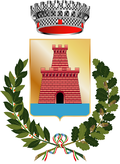Abbateggio | |
|---|---|
| Comune di Abbateggio | |
 | |
| Coordinates: 42°14′N14°1′E / 42.233°N 14.017°E | |
| Country | Italy |
| Region | Abruzzo |
| Province | Pescara (PE) |
| Frazioni | Catalano, Cusano, Di Mezzo, Le Piane, San Martino, Scalelle |
| Government | |
| • Mayor | Gabriele Di Pierdomenico [1] (Uniti per Abbateggio) |
| Area | |
• Total | 15.4 km2 (5.9 sq mi) |
| Elevation | 530 m (1,740 ft) |
| Population (1 January 2024) [2] | |
• Total | 357 |
| • Density | 23.2/km2 (60.0/sq mi) |
| Demonym | Abbateggiani |
| Time zone | UTC+1 (CET) |
| • Summer (DST) | UTC+2 (CEST) |
| Patron saint | Saint Lawrence |
| Saint day | 10 August |
| Website | Official website |
Abbateggio is a comune and town in the province of Pescara in the Abruzzo region of Italy.


